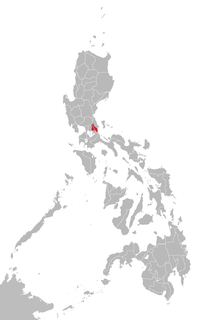Related Research Articles
The Dumpas are an indigenous ethnic group residing in Sabah, Malaysia. They reside in the kampung Rancangan Nangoh and Perancangan villages in Labuk-Suguut Subdistrict of Sandakan Division. Their population was estimated at 1,078 in the year 2000. Their language belongs to the Paitanic branch of the Austronesian language family. The language is dying out as a result of intermarriage with other groups, and since native speakers also use Tambanuo in their daily conversation.

Kadazan-Dusun also less-known as "Mamasok Sabah" are two indigenous peoples of Sabah, Malaysia—the ethnic groups Kadazan and Dusun. The Kadazandusun is the largest native group of Bumiputra in Sabah. They are also known as "Mamasok", which means "originals" or "indigenous people". Most of the Kadazan-Dusun tribes believed they are descendants of Nunuk Ragang people. Kadazan-Dusun has been recognised as an indigenous nation of Borneo with documented heritage by the United Nations Educational, Scientific and Cultural Organization (UNESCO) since 2004. Kadazan-Dusun is also recognised as a bumiputera group in Sabah that has its own special rights from land rights, rivers, to maintaining customs.
The Ida'an language is a Malayo-Polynesian language spoken by the Ida'an people on the east coast of Sabah, Malaysia.
The Murutic languages are a family of half a dozen closely related Austronesian languages, spoken in the northern inland regions of Borneo by the Murut and Tidung.
The Subanen languages are a group of closely related Austronesian languages belonging to the Greater Central Philippine subgroup. Often described as a single language, they are considered by linguists as a dialect cluster more than a monolithic language. Subanen languages are spoken in various areas of Zamboanga Peninsula, namely the provinces of Zamboanga Sibugay, Zamboanga del Norte and Zamboanga del Sur, and in Misamis Occidental of Northern Mindanao. There is also a sizeable Subanen community in Misamis Oriental. Most speakers of Subanen languages go by the name of Subanen, Subanon or Subanun, while those who adhere to Islam refer to themselves as Kalibugan.
The Dusunic languages are a group of languages spoken by the Bisaya and Dusun, and related peoples in the Malaysian province of Sabah on Borneo.
The Paitanic languages are a group of languages spoken in Sabah (Borneo) Several go by the name Lobu.
The Sabahan languages are a group of Austronesian languages centered on the Bornean province of Sabah.

Remontado, also known in literature as Sinauna, Kabalat, Remontado Dumagat, and more commonly by the autonym Hatang Kayi, is a Malayo-Polynesian language spoken in Tanay, Rizal, General Nakar, Quezon, Rodriguez, Rizal and Antipolo, in the Philippines. It is one of the Philippine Negrito languages. It is a moribund language.
Tombonuwo (Tambonuo) is a Paitanic language spoken in the Pitas and Labuk-Sugut Districts of northwest Sabah, Malaysia.
Tatana (Tatanaq) is a Sabahan language spoken in Sabah, Malaysia. Due to limited studies, it is hard to ascertain whether Tatana requires a category on its own or is considered a Bisaya variety based on its 90% linguistic intelligibility with the closely related Bisaya ethnic in Sabah. The current speakers of Tatana identify themselves as an ethnic subgroup of the Dusun people of Borneo. Jason Lobel (2013:360) classifies Tatana as Murutic rather than Dusunic.
Magahat, also called Southern Binukidnon or Buglas Bukidnon, is a Central Philippine language of the mountains of Negros in the Philippines that has been strongly influenced by Cebuano and Hiligaynon. It is similar to Karolanos; Lobel (2013) suggests that it is a Bisayan language.
Inagta Rinconada is a Bikol language spoken by a semi-nomadic hunter-gatherer Agta (Negrito) people of the Philippines. It is spoken to the east of Iriga City up to the shores of Lake Buhi. The language is largely intelligible with Mount Iraya Agta on the other side of the lake.
Mount Iraya Agta is a Bikol language spoken by a semi-nomadic hunter-gatherer Agta (Negrito) people of the Philippines, east of Lake Buhi in Luzon. It is mutually intelligible with Mount Iriga Agta on the other side of the lake.
Casiguran Dumagat Agta, also known as Casiguran Agta, is a Northeastern Luzon language spoken in the northern Philippines. It is spoken by around 610 speakers, most of whom live in the San Ildefonso Peninsula, across the bay from Casiguran, Aurora.
Umiray Dumaget Agta is an Aeta language spoken in southern Luzon Island, Philippines.
Ganaʼ is an Austronesian language of Sabah, Malaysia.
Nagtipunan Agta is a Northeastern Luzon language. It is one of the Aeta languages. The language was discovered by Jason Lobel and Laura Robinson in Nagtipunan, Quirino. Nagtipunan Agta is most closely related to Casiguran Dumagat Agta.
Dinapigue Agta is a Northeastern Luzon language. It is one of the Aeta languages.

The Beluran District is an administrative district in the Malaysian state of Sabah, part of the Sandakan Division which includes the districts of Beluran, Kinabatangan, Sandakan, Telupid and Tongod. The capital of the district is in Beluran Town.
References
- ↑ Dumpas at Ethnologue (18th ed., 2015) (subscription required)
- King, Julie K., and John Wayne King. 1984. Languages of Sabah: A survey report . C-78. Canberra: Pacific Linguistics, The Australian National University.
- Lobel, Jason William. 2013. Philippine and North Bornean languages: issues in description, subgrouping, and reconstruction. Ph.D. dissertation. Manoa: University of Hawai'i at Manoa.